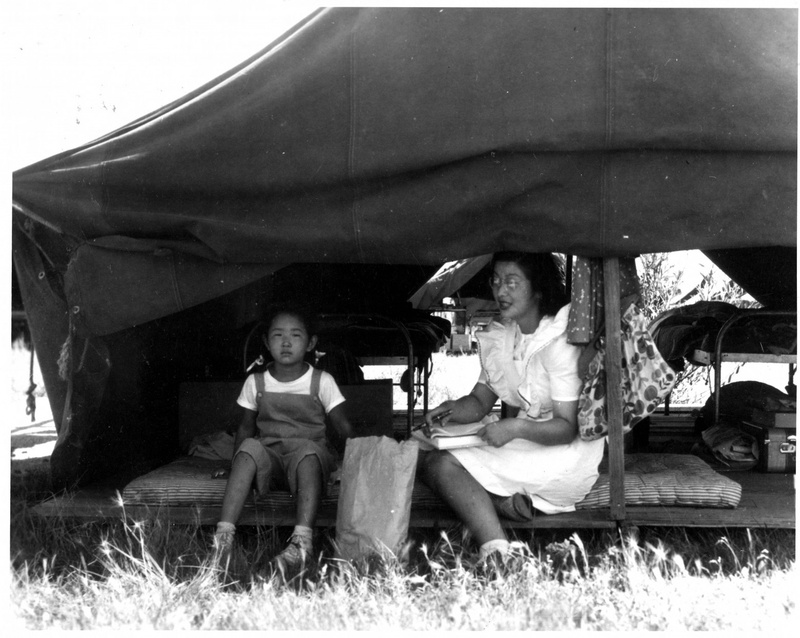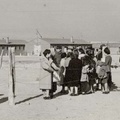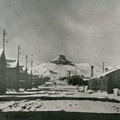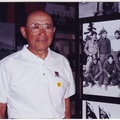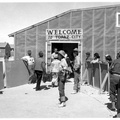HOSTILE RECEPTION FOR OUTSIDE FARM WORKERS
As at many camps, inmates were encouraged to go out on short term leave during the harvest season to do agricultural work in states like Utah, Idaho, and Colorado. Because so many workers were moving to the coast to take relatively well-paying war industry jobs, there were serious shortages of agricultural workers, leading to many farmers attempting to recruit incarcerated Japanese Americans. Thousands of Japanese Americans did do this, particularly in the falls of 1942 and 1943. So many left some of the camps in fact, that they created labor shortages in those camps.
While some at Topaz did leave to do such seasonal outside labor, the numbers were fewer for a couple of reasons. One was that the Topaz population was a largely urban one that included relatively few experienced farm workers. Another factor was the poor reception some farm workers received. One of the areas where laborers were most needed was in Utah County, where the WRA set up a housing camp in Provo that could house up to 400 Japanese American workers. Some of the workers reported that stores and restaurants wouldn’t serve them and that locals harassed them on the streets. In October 1943, some local youths even fired shots into the labor camp while the inmates were present. They refused to return to work until their safety could be guaranteed. Armed guards were quickly brought in, and the inmates did go back to work. But such incidents did little to encourage others to go out.
ISSEI AND NISEI RESISTANCE TO REGISTRATION
Widespread resistance to registration emerged at Topaz, with Issei and Nisei alike questioning various aspects of the “loyalty questionnaire” and the segregated Nisei combat unit, delaying the scheduled February 10, 1943, start of registration a week.
As detailed by Cherston Lyon in her 2011 monograph Prisons and Patriots: Japanese American Wartime Citizenship, Civil Disobedience, and Historical Memory, Issei objected to the wording of question 28 that asked a population that was prohibited by law from becoming U.S. citizens to “forswear any form of allegiance or obedience to the Japanese Emperor.” They organized a committee of nine to ask that the question be changed and refused to register until the issue was resolved. With similar complaints coming from other camps, the WRA and army agreed to change the wording of the question.
Nisei also organized a Committee of 33 to demand the restoration of their civil rights before they would agree to register. But a hard line response—included threats of prosecution for violating the Espionage Act—by both local and national WRA officials along with counter protests by professed Nisei patriots broke the Nisei protest. Registration began in earnest on February 17 and was completed by February 27. While the initial number of Nisei who volunteered for the army was low, a group of volunteers formed the Resident Council for Japanese American Civil Rights, which spearheaded a propaganda campaign that helped recruit additional volunteers.
A year later, when Nisei eligibility for the draft was restored in early 1944, two groups formed to protest the continued segregation of Nisei in the army, the Topaz Citizens Committee and Mothers of Topaz. Though a faction of the former advocated draft resistance, the majority opted to protest segregation in the army but not to actively resist conscription. The latter sent a petition signed by 1,141 mothers to President Roosevelt and other national leaders objecting to the segregated Nisei military unit and to the fact that Nisei were banned from all branches of the military except the army.
GAMBLING BOOM
Gambling became an issue at many of the WRA camps. But whereas gambling problems were mostly fueled by shadowy underground operations at other camps, they took an unusual form at Topaz. By the fall of 1943, many blocks had started bingo games as fundraisers, often for the purchase of athletic equipment. While they were effective in raising money, they had the unwanted side effect of creating bingo addicts, many of whom were children. As reports circulated of children raiding family kitties to fund their addiction, the Topaz Community Council passed an ordinance banning the bingo games, though some previously planned events were allowed to proceed at the end of the year.
To be sure, the other kind of gambling also existed at Topaz. The professional gamblers particularly targeted those who left the camp to pick sugar beets and returned to camp with a lot of cash. “The guys who stayed behind in the gambling place in camp took it all away from them in a short time,” recalled one gambler in a 1944 interview.
THE ANTELOPE SPRINGS RECREATION CAMP
A unique aspect of Topaz was the existence of a separate recreation camp for kids. The camp education department made arrangements with the Department of the Interior to use a former CCC camp near Mt. Swasey, about forty miles west of Topaz named Antelope Springs. It served as a campsite mostly for children between the ages of twelve and fourteen, often in groups organized by the Boy Scouts, Girl Reserves, or YMCA. About seventy-five kids at a time went out for stays of up to one week, accompanied by adult inmate leaders. The site was at a 7,300 foot elevation, providing a respite from summer heat, and included running mountain water, and level ground for camping.
In her Densho interview, Kazuko Iwahahsi recalled, “we slept in pup tents, two of us to a pup tent, and had open dining hall.”
“And boy, June on the lake bed out there at Topaz must have been well over a hundred degrees,” remembered Kinge Okauchi. “So this [Antelope Springs] was a great sort of respite from the hot summer.” During the summer of 1943, 338 campers went to the Antelope Springs in seven weeks.
AN EXTENSIVE LIBRARY PROGRAM
In perhaps another nod to the urban roots of the Topaz inmate population, Topaz had perhaps the most extensive library system of any of the WRA camps that included a main Topaz Public Library (TPL), a library for Japanese language material, and libraries at the high school and each of the two elementary schools.
The TPL began as essentially a continuation of the library at the Tanforan Assembly Center, with books from that library being shipped to Topaz and two former library workers from there, Ida Shimanouchi and Alice Watanabe, taking the lead in setting up the new library. Work began on the library in Recreation Hall 32 on October 2, 1942. The space was unfinished and unheated, leading to days when work had to be canceled due to the cold. Inmates contributed books and magazines to the Tanforan collection, and the library was able to open to the public with a collection of nearly 7,000 books on December 1. The TPL soon moved to the Block 16 recreation hall, essentially an entire unpartitioned barrack with mess hall tables and benches running down the middle and inmate built shelves lining the walls. The collection grew to include fifty-two periodicals, including major national newspapers as well the Oakland Tribune and San Francisco Chronicle, as well as a rental collection of new books that rented for 5¢ a week.
In January 1943, the TPL was able to rotate in some books from the Salt Lake County Library at Midvale and also initiated interlibrary loan service with college libraries in Utah and the University of California at Berkeley. By the end of March 1943, the collection had grown to over 8,500 books and patronage peaked at nearly 500 a day. It became a popular place for young people to gather to socialize and do homework. Motomu Akashi recalled spending many hours in the library, since “[i]t was much more comfortable than our apartment, especially during the winter.” He called the library “my salvation” that “brought me just that small pleasure needed to overcome my depression.”
To serve the Issei and Kibei population, a Japanese language collection was formed out of donations from inmates. Opening as a part of the regular TPL in February 1943, the Japanese section became so popular that it moved to its own space in Recreation Hall 40 in May, later moving to Recreation Hall 31 in February 1944. The collection began with about 1,000 books and eventually grew to 5,000, with daily attendance of three hundred. The inmates from Hawai‘i became frequent users of the library and put on a popular exhibition of craft items in Hawaiʻi. Later, the Japanese library hosted exhibitions of artists from the art school.
*This article was originally published on the Densho Blog on September 11, 2019.
© 2019 Brian Niiya / Densho



